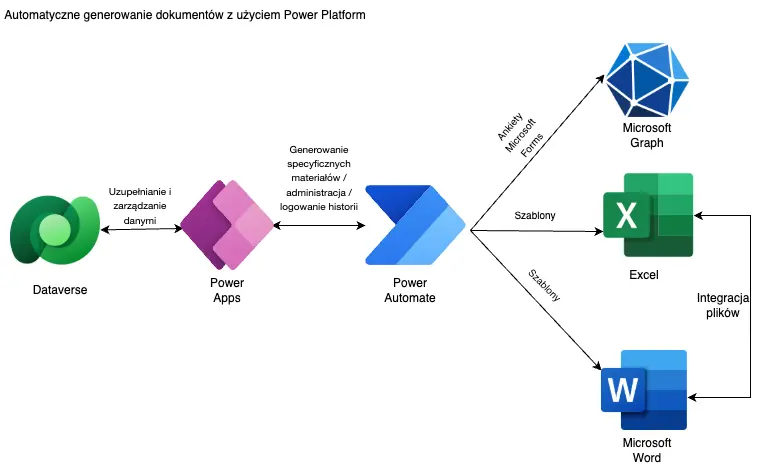Are You Still Manually Copying Data Between Spreadsheets and Templates?
Employees spend an average of 35% of their time on administrative tasks—that’s around 14 hours per week per person!
One of the biggest challenges in admin work is generating and updating documents, especially at scale. Across many organizations, we keep encountering the same question:
How can we eliminate repetitive manual work that involves copying data from one place and pasting it into another? See below visualization of the challenge:
Here’s what we commonly see clients doing:
- Copying data from one Excel table to another
- Copying Excel data into Word files
- Fixing formatting issues caused during copying
- Manually creating surveys in Microsoft Forms
- Manually pulling company data from registers (like KRS) into contracts
- Manually generating contracts using inputs from CRM, KRS, or Excel spreadsheets
How Do You Fix This? The solution isn’t AI—it’s often a matter of using tools you already have, but haven’t fully explored. This is where document automation comes in.
Automated document generation - how to start?
Start with tools:
Steps to Implement Automated Document Generation:
- Standardize your document templates
- Prepare structured lists of data to be used in those documents
- Automate the process by feeding the lists into the templates and generating the documents in the right place
Check here how the process works
Have similiar challenge? Contact us!
Alternative Approaches Worth Considering:
🔄 Use existing features in your ERP or CRM – Many enterprise tools support automated document generation based on records and templates.
🔄 Adopt workflow management systems – There are many workflow tools on the market that allow for streamlined document generation. However, not all of them offer native integration with Microsoft Word or Excel templates.
🔧 Programmatic document generation using Python – Python libraries can handle Word and Excel automation with high flexibility. This approach requires technical skill but gives full control over the document creation process.
Document Automation: Expected Results
80%
time savings
2
Weeks to see first results
20
$20/user/ month*
- Koszt licencji Power Automate premium. Cena może zmienić się w zależności od wybranych funkcjonalności w projekcie i produktów do użycia. Więcej w FAQ niżej.
What’s the Added Value of Document Automation?
- A scalable solution—cost doesn’t rise linearly like with new hires
- Compatible with all Microsoft templates (Word, Excel, Forms)
- New digital skills transferable across business processes
- Higher quality materials, fewer formatting errors
- Better employee experience through less manual work
- Reduced risk—no more “only one person knows the process” bottlenecks
Key Challenges When Implementing Automated Document Generation
Each automation required solid fundament in data to be scalable.
Who Can Benefit from Document Automation?
If your organization generates 50+ repetitive documents per month, and sends them for printing, emailing, or system uploads—you’re a strong candidate.
Training Companies
- Survey generation
- Training material creation
- Visual identity elements (badges, labels)

Professional Services
- Document template generation
- Contract creation
- Client or internal reporting

Business Process Outsourcing
- Client reports
- Employee contracts
- Contract annexes

Is It Worth Implementing Document Automation?
📍 Yes! If your business creates at least 50 recurring documents monthly, there’s strong automation potential. From there, you can personalize them further using language models and internal knowledg
📍 First step? Audit your manual processes. Count how many document flows you currently manage, how much time they consume monthly, and standardize your templates. Once that’s ready—reach out, and we’ll help you automate.
Frequently Asked Questions About Document Automation
Key questions and objections related to automated document generation
The starting cost is 5,000 PLN, and the final price depends on the products used and the scale of automation. Alternatively, you can choose a competency-building model, where an internal employee is trained to build and manage automations within the company.
The minimum cost starts at 80 PLN (Power Automate Premium). Final costs depend on the licenses already available in your organization. Example setup:
- Microsoft Business Premium – €20.60 Power Apps Premium – $20 Power Automate Premium – $20 = Approx. 250 PLN/month
- No usage limits
- Additional connectors/plugins may carry extra costs in Power Automate
The system supports Microsoft Word and Excel files for automation. ❌ PowerPoint files are not supported.
A full rollout including testing and optimization takes about 2–3 weeks. You can start with a pilot project on a small document sample to get results even faster.
Using large language models (LLMs) or AI agents for document creation is promising—but there are limitations:
- LLMs do not work well with predefined templates and often fail to recognize structured fields
- AI agents rely on LLMs and inherit the same limitations
- AI tools cannot automatically fetch data from systems like KRS or your internal databases—this requires custom integration
requires custom integration However, AI can be used to personalize content or add summaries as part of a broader document automation workflow
Automate Your Document Generation
Want to evaluate the time and cost savings potential of document automation in your company? Let’s talk – we’ll help you assess the business case and guide you through next steps.
